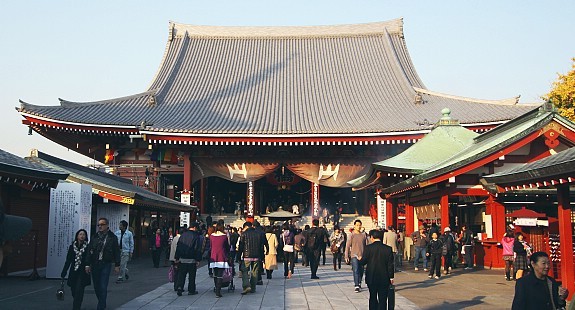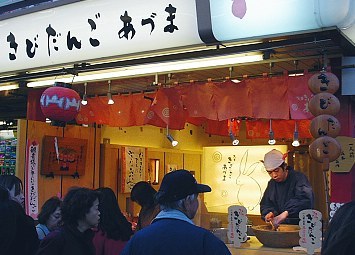why I want to go to Japan
Tuesday, November 22, 2011
Sushi!
Differences between Sushi in the U.S. and Japan:
1) Freshness: When it comes to fish, freshness is quality. The freshness of the seafood is what really stood out. One trip to the Tsijiki food market in Tokyo showed why. Fish of varied shapes, sizes and colors jumped around soon to meet the fateful knife, while Japanese fisherman scooted around the market floor on scooters attached to drums. The freshness and care given to the seafood was amazing. Of course you can find good quality seafood in the United States, though you generally have to pay a high premium for it. Fresh fish in Japan almost felt like a birthright.
2) Lack of Rolls: Sushi rolls are what got me hooked on eating raw fish. A little bit of fresh or cooked fish, an avocado slice, maybe a cucumber, and topped with some fish eggs, wasabi and ginger...certainly that is the quintessential piece of sushi here right? Couldn't find it in Japan. What we call sashimi in the US was pretty much all that was available. That or a piece of fresh fish, a hint of wasabi underneath, and followed on the bottom with some pure white rice. While their sushi was fresh and delicious, and highlighted the quality of the seafood, I may have to confess my all-encompassing love of the sushi roll and give the United States the edge here. After all, we do have sashimi and more basic rolls. But the avocado sushi combination is just too wonderful to forget.
3) Conveyer Belt: Yes, one thing we just don't seem to have in the United States is conveyer belt Sushi. But boy is it fun. Plates of varying colors spin round the dining room and you take what you like, paying by the plate. At the end, they sum up the plates you bring to the counter, and you leave stuffed to your heart's content.
Sushi has proven to be a pretty variable cuisine. The American version of sushi in roll form with the mixed vegetables is an interesting twist. However, the simplicity and freshness of sushi, in odd locales such as a conveyer belt restaurant, make the experience of eating sushi in Japan a long lasting and wonderful memory.
Monday, November 14, 2011
Japanese Macaque like to sit in the hot tub
Jigokudani Monkey Park (地獄谷野猿公苑 Jigokudani Yaen Kōen) is in It is part of the Joshinetsu Kogen National Park (locally known as Shigakogen), and is located in the valley of the Yokoyu-River, in the northern part of the prefecture. The name Jigokudani, meaning "Hell's Valley", is due to the steam and boiling water that bubbles out of small crevices in the frozen ground, surrounded by steep cliffs and formidably cold and hostile forests.
The heavy snowfalls (snow covers the ground for 4 months a year), an elevation of 850 meters, and being only accessible via a narrow two kilometer footpath through the forest, keep it uncrowded despite being relatively well-known.
It is famous for its large population of wild Japanese Macaques (Macaca fuscata), more commonly referred to as Snow Monkeys, that go to the valley during the winter, foraging elsewhere in the national park during the warmer months. Starting in 1963, the monkeys descend from the steep cliffs and forest to sit in the warm waters of the onsen (hotsprings), and return to the security of the forests in the evenings.
I want to definitely see these monkeys!!!
Monday, November 7, 2011
Reason 1 Sensoji Temple
Sensoji Temple
When approaching the temple, visitors first enter through the Kaminarimon (Thunder Gate), the outer gate of Sensoji Temple and the symbol of Asakusa and the entire city of Tokyo.
A shopping street of over 200 meters, called Nakamise, leads from the outer gate to the temple's second gate, the Hozomon. Alongside typical Japanese souvenirs such as yukata and folding fans, various traditional local snacks from the Asakusa area are sold along the Nakamise. The shopping street has a history of several centuries.
Sensoji (浅草寺, Sensōji, also known as Asakusa Kannon Temple) is a Buddhist temple located inAsakusa. It is one of Tokyo's most colorful and popular temples.
The legend says that in the year 628, two brothers fished a statue of Kannon, the goddess of mercy, out of the Sumida River, and even though they put the statue back into the river, it always returned to them. Consequently, Sensoji was built nearby for the goddess of Kannon. The temple was completed in 645, making it Tokyo's oldest temple.
A shopping street of over 200 meters, called Nakamise, leads from the outer gate to the temple's second gate, the Hozomon. Alongside typical Japanese souvenirs such as yukata and folding fans, various traditional local snacks from the Asakusa area are sold along the Nakamise. The shopping street has a history of several centuries.
Japan offering free flights!
Japan is hoping to offer 10,000 free flights to Japan in the summer of 2012 to people who can help share the word about the benefits of Japan.
If approved by the government, anyone will be able to sign up online in April 2012 and state how they can, “communicate their experiences through blogs and social networking during and after their trips.” Those who can show the most benefit for Japanese tourism will be most competitive in the selection process.
Winners will be offered free airfare, but any other expenses have to be covered by the person. However, there is a good chance that hotels in the region will also offer great deals for promotions to visitors.
The aim of this project, called “Fly to Japan!” is to:
* Eliminate worries about travel to Japan through positive words by actual travelers
* Increase of domestic comsumption by spending during travel
* Development of new tourist routes and resources.
It has always been a dream of mine to go to Japan, so I hope to blog about the reasons I want to go there and hopefully win some tickets!!
If approved by the government, anyone will be able to sign up online in April 2012 and state how they can, “communicate their experiences through blogs and social networking during and after their trips.” Those who can show the most benefit for Japanese tourism will be most competitive in the selection process.
Winners will be offered free airfare, but any other expenses have to be covered by the person. However, there is a good chance that hotels in the region will also offer great deals for promotions to visitors.
The aim of this project, called “Fly to Japan!” is to:
* Eliminate worries about travel to Japan through positive words by actual travelers
* Increase of domestic comsumption by spending during travel
* Development of new tourist routes and resources.
It has always been a dream of mine to go to Japan, so I hope to blog about the reasons I want to go there and hopefully win some tickets!!
Subscribe to:
Posts (Atom)




